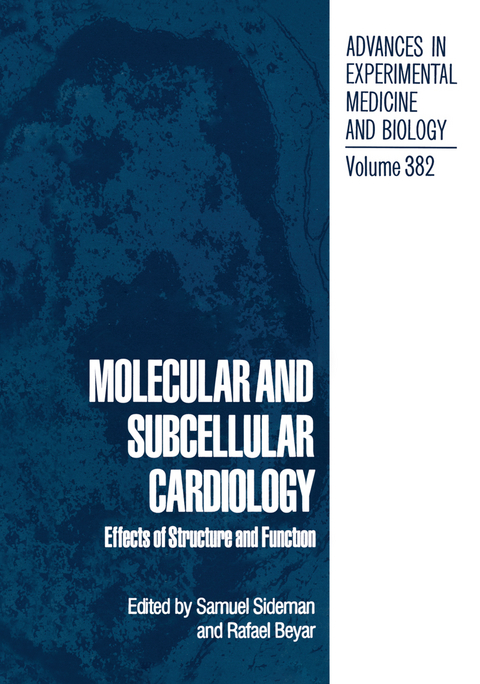
Molecular and Subcellular Cardiology
Springer-Verlag New York Inc.
978-1-4613-5772-8 (ISBN)
Molecular Mechanisms of Sarcolemar Excitability.- 1 Ion Channels and Pumps in Cardiac Function.- 2 Molecular Mechanisms of K+ Channel Blockade: 4-Aminopyridine Interaction with a Cloned Cardiac Transient K+ (Kv1.4) Channel.- 3 Na+, K+-ATPase and Heart Excitability.- 4 Excitation-Contraction Coupling in Ventricular Myocytes: Effects of Angiotensin II.- 5 Prospects for Genetic Manipulation of Cardiac Excitability.- 6 Integrative Models and Responses in Cardiac Ischemia.- 7 Rich Dynamics in a Simplified Excitable System.- 8 Model Studies of Cellular Excitation.- Intracellular Calcium and Muscle Function — SR and Filaments.- 9 Confocal Microscopy Reveals Local SR Calcium Release in Voltage-Clamped Cardiac Cells.- 10 Signaling of Ca2+ Release and Contraction in Cardiac Myocytes.- 11 A Model of Ca2+ Release from the Sarcoplasmic Reticulum.- 12 Troponin C — Troponin I Interactions and Molecular Signalling in Cardiac Myofilaments.- 13 The GATA-4 Transcription Factor Transactivates the Cardiac-Specific Troponin C Promoter-Enhancer in Non-Muscle Cells.- 14 Sarcomere Function and Crossbridge Cycling.- 15 Crossbridge Dynamics in Muscle Contraction.- 16 Mechanisms of the Frank-Starling Phenomena Studied in Intact Hearts.- Molecular Manifestations of Cell Adaptation.- 17 Metabolic Oscillations in Heart Cells.- 18 Altered Gene Transcription following Brief Episodes of Coronary Occlusions.- 19 Mechanoperception and Mechanotransduction in Cardiac Adaptation: Mechanical and Molecular Aspects.- 20 Molecular Manifestations of Cardiac Hypertrophy in the Spontaneously Hypertensive Rat Effects of Antihypertensive Treatments.- 21 Regulation of Adenosine Receptors in Cultured Heart Cells.- 22 A Model Approach to the Adaptation of Cardiac Structure by Mechanical Feedback in the Environmentof the Cell.- 23 The Effect of Cytotoxic Lymphocytes on Contraction, Action Potential and Calcium Handling in Cultured Myocardial Cells.- 24 Ventricular Remodeling in Heart Failure: the Role of Myocardial Collagen.- Analysis and Modeling: From Microstructure to Macro-Performance.- 25 Mechanisms of Endocardial Endothelium Modulation of Myocardial Performance.- 26 Myocardial Microcirculation as Evaluated with CT.- 27 Vascular Gene Therapy.- 28 Integration of Structure, Function and Mass Transport in the Myocardium.- 29 Hypertrophic Cardiomyopathy: Functional Aspects by Tagged Magnetic Resonance Imaging.- 30 Myocardial Constitutive Laws for Continuum Mechanics Models of the Heart.- 31 Distribution of Myocardial Strains: An MRI Study.- Closure.- Toward Modeling the Human Physionome.- The Editors.- List of Contributors.
| Reihe/Serie | Advances in Experimental Medicine and Biology ; 382 |
|---|---|
| Zusatzinfo | XVIII, 354 p. |
| Verlagsort | New York, NY |
| Sprache | englisch |
| Maße | 178 x 254 mm |
| Themenwelt | Naturwissenschaften ► Biologie ► Botanik |
| Naturwissenschaften ► Biologie ► Zoologie | |
| Naturwissenschaften ► Physik / Astronomie ► Angewandte Physik | |
| ISBN-10 | 1-4613-5772-1 / 1461357721 |
| ISBN-13 | 978-1-4613-5772-8 / 9781461357728 |
| Zustand | Neuware |
| Informationen gemäß Produktsicherheitsverordnung (GPSR) | |
| Haben Sie eine Frage zum Produkt? |
aus dem Bereich


